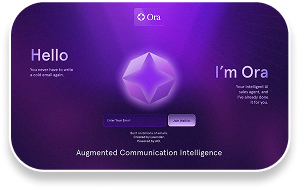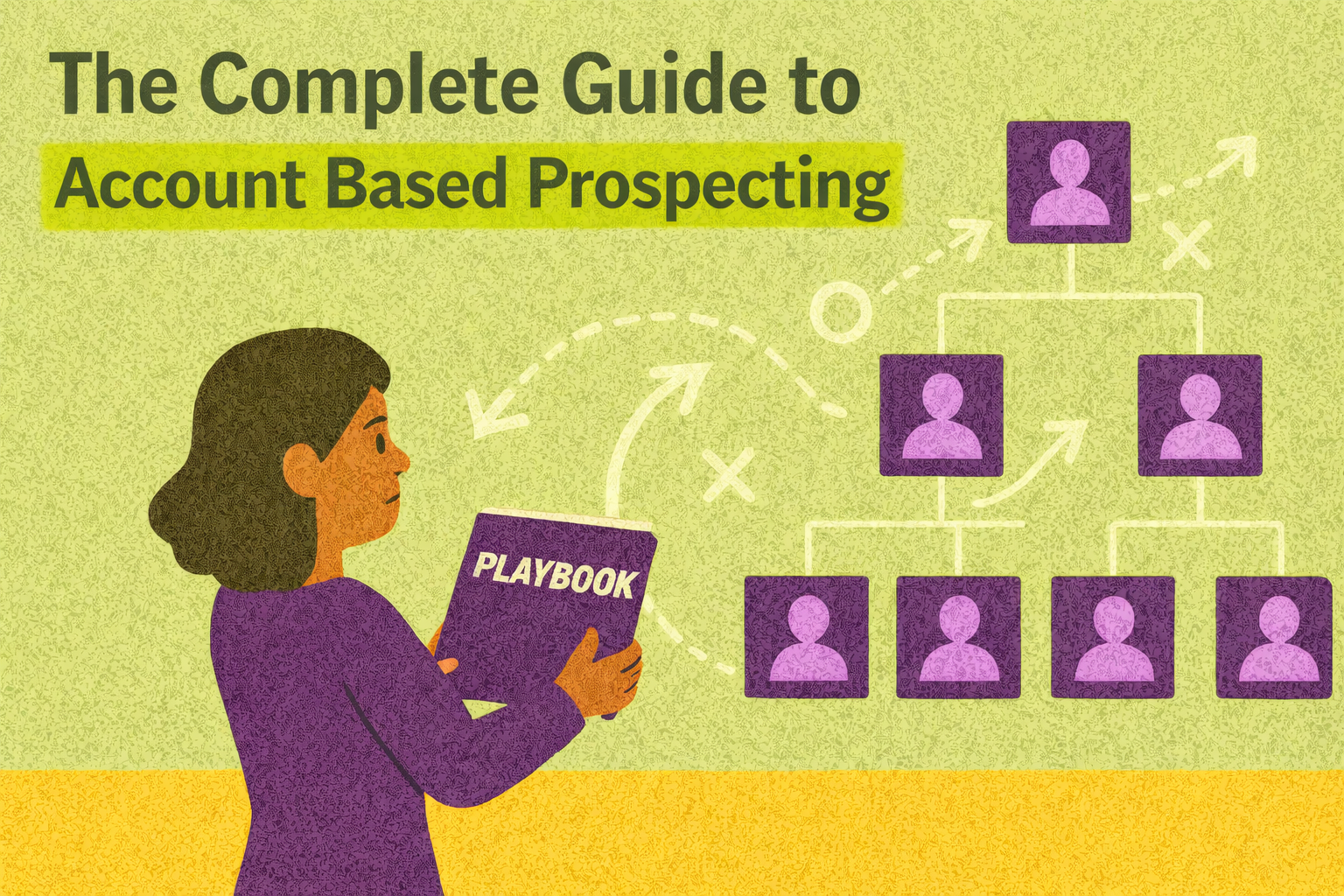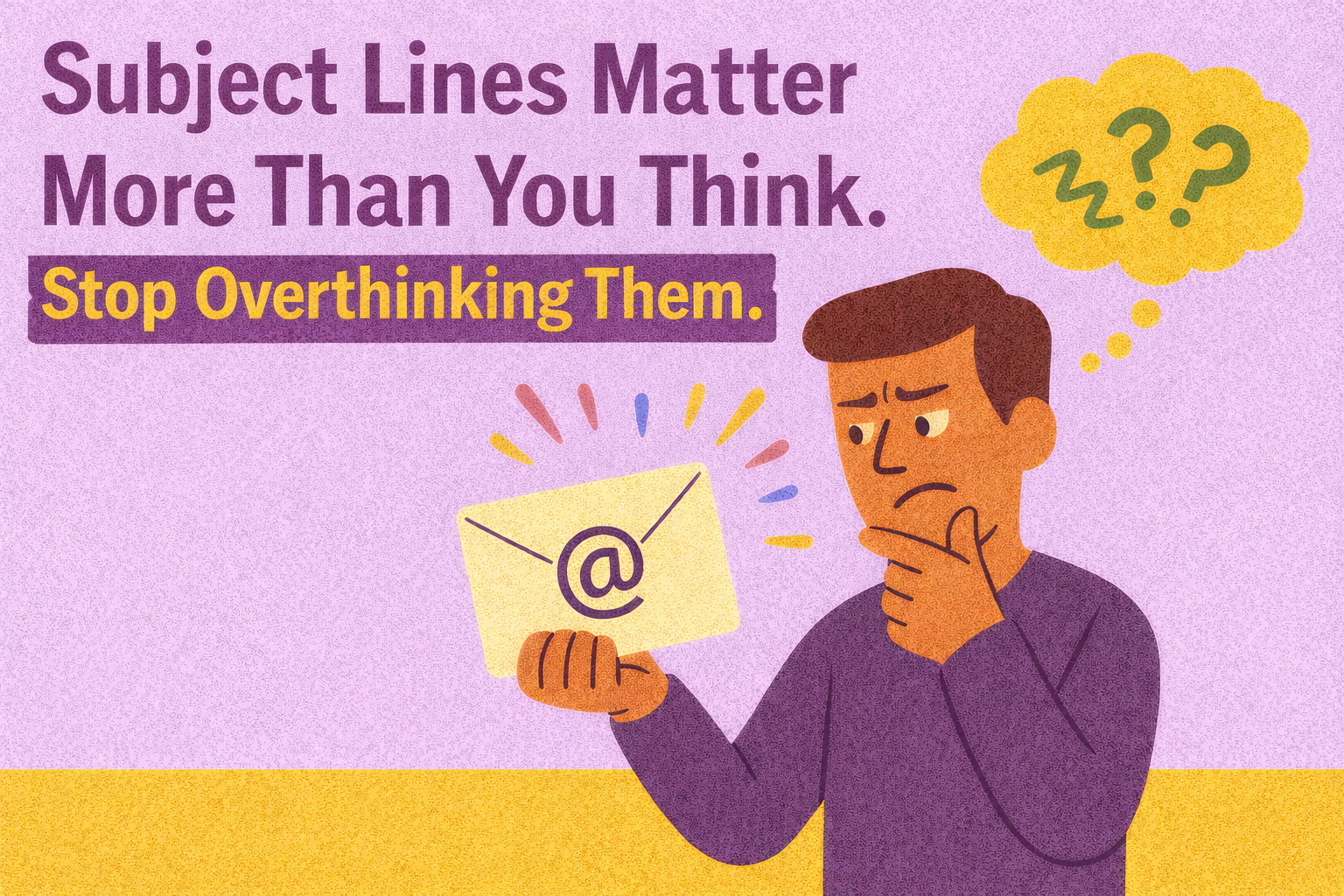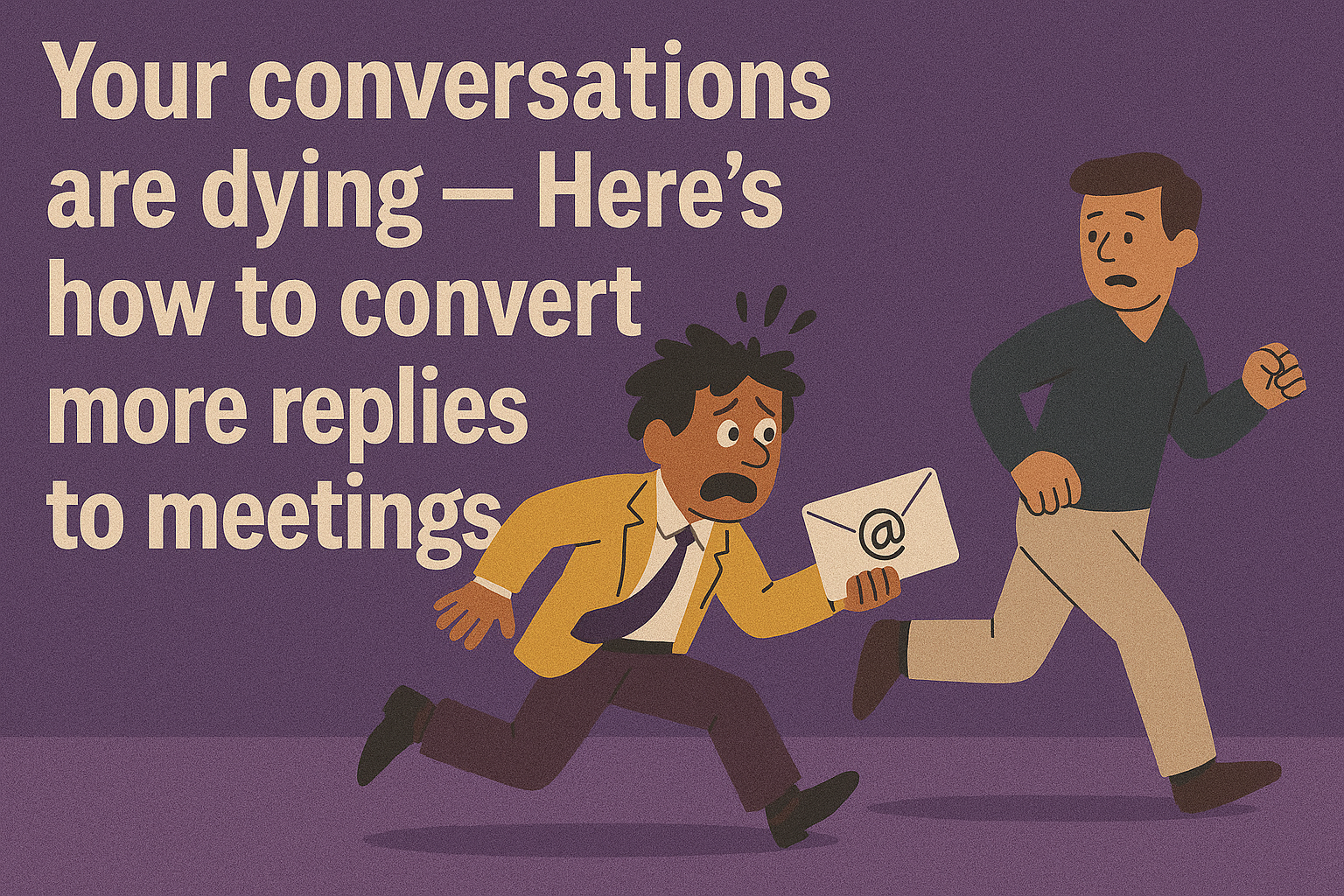Cold Email 101: How to Write Emails People Actually Read (and Reply To)
It's harder than ever to sell right now. No need to fret; we're here to help. Cold email is one of the most effective methods for outbound sales prospecting. You need to lean into it more than ever for success in this climate. Here's everything you need to feel confident with cold email.

Do you know how to write a cold sales email? It's more important than ever.
Why? Because it’s harder than ever to sell right now.
The market is uncertain, budgets are down, headcounts have shrunk, and risk aversion is high.
No need to fret; we’re here to help. Cold email is one of the most effective methods for outbound sales prospecting. You need to lean into it more than ever for success in this climate.
Here’s everything you need to feel confident with cold email.
What Is a Cold Email?
A cold sales email is sent to a prospective buyer who doesn't know you yet.
The goal of a cold email is not to blast your entire list of target customers or be spammy (i.e., be a nuisance). Instead, a cold email aims to present a valid solution to prospects most likely to benefit and experience related pain.
Treat your email like an invitation to a conversation. A good cold email requires a valid reason for showing up. This means the email has clear logic for the problem you think you can help the recipient solve. They should know why you think they have that problem in the first place.
In B2B (business to business) sales specifically, you’re usually responsible for booking meetings to drive new customer pipeline and revenue. Cold emails are a way to achieve that. But the problem is, when you attach that goal to your writing, you come across as spam.
An excellent cold email isn’t trying to close the deal or pitch your product. Just like you wouldn’t ask for marriage on a first date, don’t aggressively pitch your product right away.

Tip No. 1: Don’t forget there’s a human on the other end of the email you’re writing. That means remembering:
- Respect: Their time and energy are limited.
- Brevity: Others are vying for their attention in (and out of) the inbox.
- Empathy: They want to be spoken to like a human.
- Aversion: Humans are pain avoiders; focusing on pain is more effective than focusing on rewards.
With a cold email, you’re seeking to start a conversation. The best conversation starters are questions that:
- Build credibility through your understanding of their problems.
- Imply that you have a solution to share.
- Encourage the prospect to talk about themselves (make it easy for them to respond).
Lavender helps thousands of sellers worldwide send better emails faster—and feel confident while improving.
Cold Sales Email Framework
Here’s a sample framework of these ideas in action.
Part 1
Make an Observation: Lead with your research.
It’s important your recipient knows the email is for them. Most decision-makers receive, and ignore, dozens of emails per day. When you show you’ve researched them, they’re more likely to open your email and respond.
Use a familiar name, pull from their experience, social media activity, and news from their company or competitor. Aim to establish credibility in one to two sentences. Double-check your data for accuracy before sending. If your research is incorrect it will seem disingenuous, and they’re less likely to reply.

For example, data like a company’s tech stack are frequently outdated because it changes often. If you’re not 100% sure, lead with that uncertainty or choose something else. Either way, don’t be afraid to be corrected. If it happens, brush it off and keep the conversation going: at least you got a reply!
Part 2
Make a Connection: What does that research tell you?
Finding interesting facts and research is easy. Making it relevant is the tricky part. Anyone can list research, but the best reps turn research into a hypothesis. Personalization isn’t about where they went to school. Instead, your research should lead them to the problem you solve.
The more you can show the reader you understand the implications of your research and how it impacts their business needs, the more credibility you build.
This is what separates a good cold email from a great one. You need to build credibility quickly by showing you understand and can solve your reader’s unique problem.
Part 3
Build Credibility: Give the context behind the research.
Now that you have their attention, validate why you’re speaking to them about this problem.
This can be done through credibility builders and social proof like sharing similar and relevant clients you work with.
It can also be a simple sentence explaining what you do.
Don’t go overboard here. Avoid industry jargon and buzzwords. Make the one-sentence pitch clear and easy to understand.
Part 4
Ask a Question: Open it up for a conversation.
You may have heard of a call to action (CTA — more on this later). This phrase is common marketing jargon to help drive conversion: an action like a click or purchase.
Sellers mostly know cold email CTAs as a push to book time for a call or meeting to learn more.
This is a limiting understanding of how a buyer makes their purchase decision.
Instead, the only goal of a cold email is to get a reply. The sale comes later.
That’s why the most important thing to focus on is starting a conversation.
Instead of a CTA, use a CTC: the call to conversation.
That can be:
- Asking if it’s worth learning more.
- Clarifying if something is a priority.
- Understanding their business needs and problems.
- Uncovering if they have or are using similar solutions.
- Seeking clarification if your hypothesis and research are correct.
- Seeing if another (well-researched) individual would be a better contact.
- Looking to see if they want you to send additional resources over to help.
Whatever your conversation starter is, make sure it’s easy to reply to. Don’t ask open-ended questions.
Here’s an example of the framework in action:
Hey {first name},
Since you’re hiring new reps in Nashville (saw your post), I was curious to see how they’ll be managed compared to the NYC team.
It looks like the leadership team is focused in NYC.
Our email coaching tech could take some of the onboarding burden off your team. This allows you to focus on bigger issues than “did they write a good email."
Sound interesting… or are you hiring a local manager?
Will
This shows: I've done my homework, am credible, anticipate their problem, and offer a potential solution.
Ready to dig into best practices to write your own? Wait … that email example needs a subject line.

How to Write Cold Email Subject Lines
Your subject line is your reader’s first impression of you. It can make or break whether they open your email or not. It can also be the most challenging part of writing an email.
The biggest reason? You overthink it.
A subject line is more likely to hurt you than it is to help you.
While getting creative with it is fun, you need to be careful. Your buyer categorizes what they believe your message is before they open it. If they see your subject and think, “sales pitch,” you’re fighting an uphill battle.
Keep these tips in mind:
- Title case
- Neutral tone
- Boring is best
- Short 1-3 words
- Descriptive of what’s in the email
- Make it sound like an internal email
And avoid:
- Verbs
- Numbers
- Questions
- First names
- Commands
- Superlatives
- Punctuation
- Clichés
So in our email example above:
Instead of “Will, how are your Nashville reps onboarding?
Use “Coaching Priority” or “Nashville Sales Lead Question.”
You’re competing for room in your reader's inbox. They’re getting many other emails from their team, boss, and other vendors, including your competition.
Instead of thinking about the subject line as a way to get them to open the email, keep it simple, so they don’t delete it.
Why? Don’t Forget About Preview Text.
If you approach your subject line correctly, the preview text will have the most important role to play.
Preview text is the copy line that appears next to your subject line in the inbox — also known as the real reason why they open (or delete) your email.
It’s also what they see when they get a notification on their phone or smartwatch.
For many readers, they decide whether or not they open an email from the preview text alone.
Good preview text can boost subject line performance and ensure your emails are opened.
The preview should show the reader the message is written for them and, ideally, will be relevant to them. This space is limited, so avoid cliches. Instead, pique their interest and show value immediately.
You’ll notice from the earlier framework that we start with the observation. This makes it obvious that we personalized the email specifically for them.
Clichés like “I hope this finds you well” consume the limited space you have for preview text. Since your reader receives numerous emails each day, they begin to pattern-match. Thus, seeing a cliché like this makes them think it’s just another sales email.
Tips for the Body of a Cold Sales Email
Now, we’re digging into the heart of your email. Here are some general rules to remember when writing the body copy.
Rule #1: The shorter, the better
Emails that are short and mobile-optimized see 83% more replies.
Under 75 words is best, but aim for 25-50. While this sounds short, your reader is busy. They get a lot of emails and, on average, only scan your email for 11 seconds.
Plus, humans have short attention spans. Short, concise, and direct emails are respectful of time and more likely to be read. Think about your readers' experience when they open and read your email. Your goal is to make it as easy as possible for them to read and reply.
Rule #2: Embrace white space
Your first open is 8x more likely to happen on the phone, but 90% of sales emails are written on a desktop. This causes a disconnect in formatting because emails look different on a desktop than a phone. It results in blocks of text that become big paragraphs and are easier for your reader to skip over when they scan your email.
Instead, break up your email into multiple one-line sentences or short paragraphs (1-2 sentences). It’s easier to read (i.e., most people scan in 11 seconds), and it’s essential to creating a mobile-optimized email that gets replies.
Fun fact: A single line in Outlook or Gmail on the desktop becomes two to four lines on a phone view. Those add up quickly, and make your email look a lot longer than it really is.
Rule #3: Clear is kind
If you’re reading this, your emails are probably too complicated. 70% of cold emails are written at or beyond a 10th-grade reading level.
You might think this is good, but you’re missing out on replies.
Don’t make the mistake of using big words to sound smart. Credibility comes from understanding the buyer’s situation and problems. It doesn’t stem from jargon.
Your reader is skimming. You need to ensure they understand your writing quickly.
Using buzzwords, jargon, adverbs, long words, and long sentences will make it harder to read or skim your email. It doesn’t matter if your prospect is smart; they’re still busy.
Our data shows writing at a 3rd to 5th-grade reading level gets 67% more replies.
And yes, we’ve tested this across different personas and industries. It doesn’t matter. People are people: they scan emails for key points.
Rule #4: Watch your tone
Even a CEO is human. So don’t be afraid to talk like one. CEOs are known for being brief and direct, aiming to move on to the next task on their list. Your buyer is the same.
If your email is too formal, you hurt your chance of reply. But you also don’t want to be too casual — calling a c-suite decision-maker “bro” will probably not land well. Be polite, positive, confident, and informal (but not too familiar) when writing.
Put simply, be friendly and casual — while also professional and clear.
A good test is to read your message out loud. Would you be embarrassed to say it to a friend or family member? If so, you might be striking the wrong tone.

Rule #5: Make sure it delivers
All your effort is wasted if your email doesn’t even land in the inbox. And today, spam filters are strong. The body of your email significantly impacts keeping your email out of the junk folder. Most importantly: send good emails, and this won’t happen.
Here are some tips to keep in mind:
- Avoid including images
- Don’t include links in your email
- Don't send the same message over and over
- Don’t send more than 50 cold emails in one day
- Don’t send too many emails at once – space them out
- Avoid spammy words (e.g., free trial, investment opportunity)
Plus, talk with your email administrator to ensure your mail server settings are correct. (Bonus, we busted some common deliverability myths.)
Rule #6: Toss the clichés
I hope this finds you well. Do you have 15 minutes? I’m sure you’re busy.
These are a few examples of commonly used and abused clichés. Cut ‘em all.
It’s not that clichés are inherently bad (well, maybe except for the insincere platitude of “I hope this finds you well”). But some are so overused that buyers immediately filter cliché messages as spam. They are immediate turn-offs.
How to Personalize a Cold Email
Over 150,000 emails are sent every minute. In 2023, the average person receives about 121 emails a day. That’s a lot of freaking emails.
How are yours going to stand out? → You have to write to the person so that they know you know them. Or at least, like you’re trying to know them. But not like, in a creepy way.
You have to show your recipient your email is for them. Here’s how to personalize:
- Visit their website, Google them, and visit their social media profiles (and their company’s).
- Look up information about their company, the folks they work with, what’s going on in their market, and in the markets they sell to.
- Look for observations you can include references to in your email that will let them know you’ve done your homework.
But be careful. You can’t just slap a random fact from their LinkedIn profile into your intro line and expect them to care. It also has to be relevant. Your personalized message has to neatly connect to the problem your product or service solves.
Make an observation. Example: "I saw you're hiring for sales reps."
And then share an insight or problem based on the observation. Example: "I’m guessing you’re already thinking about how you’ll ramp those new reps."
Understanding the Problem
If you remember nothing from this article but one thing, let it be this: your buyer doesn’t care about you.

Put yourself in your buyer’s shoes. We all receive sales and marketing emails. And the vast majority of them are trying to sell something. The focus of these emails is on: products, benefits, features, prices, or other successful customers.
The issue? Humans only care about these things when they’re already shopping for a solution or product, or if they’re prone to impulse decisions. And that’s rare in B2B — people are either in buying mode or not.
So the crux of your email body is focusing on your recipient's problems. Either they haven’t yet realized it or don’t know of a solution (or a better solution) for it yet.
Use the personalization + relevance tips above to tie your email copy to a challenge your prospect faces.
Cold Email Credibility
Now it’s time for your pitch…
Just kidding. Credibility can come from several places. It can come from how you connect the observations and problems the reader faces. It can also come from data supporting what you do. The most common place to pull credibility is from similar or well-known customers who have handled the issue you just introduced.
Examples:
- Dunder Mifflin’s finance department used us and saved the payroll headaches!
- Walmart easily avoided losing sales by adding our real-time analytics.
- We saved Bikes-R-Us (and other mature stores) 5% in fees with no feature loss.
Be careful with these examples. If you’re contacting a startup, they likely don’t care that you help Starbucks with their payroll. Ask yourself, “is that example actually relevant to the reader?” Your goal is to choose a customer story that resonates with your reader: similar size, industry, and problem.
The Cold Email Call to Action
You’ve hit the three targets: Observation, problem, and credibility — time to close.
CTAs are actually for marketing. You don’t want to ask for the meeting in your cold sales email.
Ten times out of ten, the person you’re emailing is busy. Their calendars are full. Asking for 15 to 60 minutes of their time is a surefire way to get ignored. Hello, mental spam filter.
Instead, your CTA should focus on starting a conversation.
Remember our CTC (call to conversation)?
Once you have your first reply and build rapport, asking for a meeting is much easier. Instead of a high-friction ask, it becomes the logical next step in the conversation.
The Follow-Up Email
You’ve done everything right. Even so, you still won’t get a reply every single time.
Most teams have between a 1-5% reply rate.
Sometimes that’s how it goes, and for many potential reasons. Maybe they were pulled into a meeting and never saw it. Maybe they’re uninterested, or your shared challenges didn’t resonate. Perhaps they’re the wrong person at their company, or have other priorities right now.
Gartner reports it takes 66 activities to book one qualified meeting.

Outreach says it takes 18 touches. Lavender customers typically see about 4-5 touches.
Any way you slice it, that’s still more than one. (But if you follow these tips, you’re twice as likely to get a reply on the first try!)
Our team at Lavender averages almost 40% cold email reply rates. (Humble brag, given the average is 2%.)
But even though that’s great, it’s not perfect: it still means 60% of people we email need a follow-up.
Another scenario: Maybe your buyer responded, but it’s a rejection email. How do you follow up to that?
Maybe they say no, they don’t have a problem, or they aren’t interested. At least you have something to respond to.
Objection handling boils down to a simple phrase: “seek to understand.” Language such as, "How are you doing that today?” or “Oh, that’s great! That [technology] is a great solution. How are you using it?” can help open up your reader to continue engaging with you.
They say the fortune is in the follow-up, but we’re not suggesting you harass people who ask you to leave them alone. However, you’d be surprised by the conversations you can create.
Since people are busy, it often just takes a couple more emails to get them to engage with you. More dialogue means you might find something to work with or learn. (And it’s one more touch.)
The Proof is in Practice
Just like with anything in life, you’ll get better the more you do it.
To write is to think. Keep exercising that muscle, trying our tactics, and asking for feedback — and you’ll keep improving daily.
If there’s another way we can help you, let us know. We’ve got you. Lavender analyzes millions of emails monthly, always looking for the latest insights into what gets more positive replies.

Happy sending!
PS. Want more on cold emails? Check out Will Aitken's video, where he dives more into the topic.







